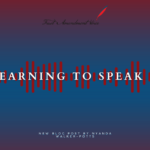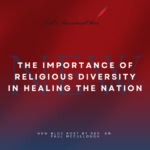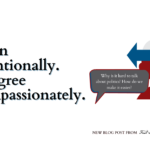
by Dan | Jan 24, 2020 | Newsletter
FAV Members,
The year 2019 brought us many surprises and blessings. FAV earned 501c3 status and quickly gained the Bronze seal of transparency with Guidestar. We have a plan to get Silver and Gold prior to this year’s Symposium in September. We doubled the size of our board of directors bringing on Lawrence Rosenberg, a senior partner with Jones Day who has litigated First Amendment issues in front of the Supreme Court, Chelsea Langston Bombino, Director of the Sacred Sector, a lawyer and new Mom, and Stan Ellis, who brings two decades of financial management experience in the nonprofit sector. FAV is extremely blessed to have these talented individuals added to our founding team and look forward to the amazing work we will do together in the future.
As last year brought great change, 2020 promises much. We start by bidding farewell to Naomi Yakawich, who has been our stalwart communications professional keeping you informed about the many things going on with FAV. Congratulations to Naomi for a recent promotion and marriage! We look forward to seeing her continue great things in her new capacity. We will also celebrate our Fifth Annual National Symposium in 2020, bringing the program back to the National Constitution Center in Philadelphia. We are excited to make speaker announcements and also let you know about the Edward D. Lowry Memorial Award for Citizenship that will be presented for the first time at the Symposium. Ed lived a life of service as an active citizen in his community, exemplifying the mantra that “Citizenship is not a spectator sport.” We look forward to honoring his life and helping inspire others to live up to the standards that Ed set for civic engagement.
Lastly, we continue our long range strategic planning process, FAV 2025. We have almost concluded the first phase and will keep you updated as the trajectory comes together. Look for more updates in the future including during our upcoming “Delegate’s Call” on January 30th. All FAV Delegates, Board, Advisors and Paid Members are invited as a benefit of their membership and contributions to raising the level of civic dialogue and helping inspire citizens to engage on issues of importance in their communities. We are extremely grateful to the support of all members who care about their communities and want to engage in constructive ways to bridge divides and continue progress through effective understanding and employment of First Amendment freedoms. Whatever your community issues, an effective grasp of the First Amendment will help you make progress.
With Gratitude, Steve & the FAV Team
Organizational Partner Spotlight
FAV is grateful to the Museum of the Bible for providing a VIP tour for FAV Friends & Family in December at no costs. Thanks to the work of the late Ed Lowry, FAV Strategic Advisor and Delegate, The Museum of the Bible hosted a dozen FAV members and family for a wonderful tour. Would you like to get a chance to see the museum? Check out the upcoming events section below for great programming coming up.
Upcoming Events
January 30 – delegate and member videoteleconference, FAV 2025, RSVP to Heather, time 8pm EST/ 5pm PST [by invitation for paid FAV members and delegates]
February 8 – Balm of Gilead, Museum of the Bible, D.C. register here
February 29 – Difficult Conversations Workshop, San Clemente, CA register here
May 12 – Dr. Cornell West, Museum of the Bible, D.C. Save the date! More info on museum website.
September 25-26 – fifth annual National Symposium, Philadelphia, National Constitution Center

by Dan | Jan 8, 2020 | Uncategorized
 Worried about ‘fake news’? You should be. Several new studies, including one by the McCombs School of Business at The University of Texas at Austin, show that for the average person, it’s extremely difficult to recognize incorrect, misleading and outright false stories on the Internet. Even more troubling, researchers at the Massachusetts Institute of Technology found that stories found to be false by six major fact-checking services often spread 10 times faster online than legitimate news stories.
Worried about ‘fake news’? You should be. Several new studies, including one by the McCombs School of Business at The University of Texas at Austin, show that for the average person, it’s extremely difficult to recognize incorrect, misleading and outright false stories on the Internet. Even more troubling, researchers at the Massachusetts Institute of Technology found that stories found to be false by six major fact-checking services often spread 10 times faster online than legitimate news stories.
Studies also show that fake news stories with clickbait headlines in many cases are getting more engagement and shares on social media than legitimate news stories. This poses a serious threat to the freedom of the press clause in the First Amendment. That’s because fake news stories are designed to distort public perceptions about real-life events, which has led to problematic consequences such as increased public distrust of media organizations, lower subscription rates for credible news outlets, higher rates of censorship, harassment and even violence against journalists and alarming incidents of people acting upon fake news stories. Remember the “Pizzagate” scandal? In 2016, Russian operatives, Twitter bots and others manufactured the ‘news’ that Hillary Clinton ran a pizza-restaurant child-sex ring. The falsehood went viral, shaping public perception of Clinton. A North Carolina man, acting on the baseless report, went on to fire an AR-15 rifle inside the pizza restaurant in Washington, D.C. that was mentioned in the baseless article.
While misleading and false news continues to appear on the Internet, news by legitimate sources continues to be attacked as ‘fake’ news. By dismissing unfavorable news stories as “fake,” individuals, many of whom have large followings on social media and in real life, are contributing to shape negative public sentiment towards journalists and media organizations.
Discrediting legitimate news stories and/or organizations by labeling them as “fake”, combined with the proliferation and increased sophistication of truly ‘fake’ news is making it increasingly difficult for members of society to discern between fact, “alternative facts,” and fiction. This only furthers public mistrust in otherwise highly credible news outlets and allows an individual’s persuasiveness to outweigh factual reporting published by diligent journalists.
To help combat the growing issue of fake news in our society, be sure to read through FactCheck.org’s guidelines for detecting fake news stories before sharing a questionable news story on social media or dismissing something you disagree with as “fake news.”

by Dan | Dec 25, 2019 | Uncategorized
 Consumer activism, which refers to citizens influencing how goods and services are produced, marketed and delivered to consumers, has been around for years. However, the instantaneous nature of digital communications has expedited the ability for consumers to rally support for their causes and persuade companies to change how they do business.
Consumer activism, which refers to citizens influencing how goods and services are produced, marketed and delivered to consumers, has been around for years. However, the instantaneous nature of digital communications has expedited the ability for consumers to rally support for their causes and persuade companies to change how they do business.
In other words, consumer activism seeks to change how a good or service is created (especially in regards to ethical and environmental issues) through various means of protest, such as boycotting certain businesses/industries, urging others to stop using a product or service, and spending more money on products/services that are sustainably produced in terms of non-wasteful materials and ethical labor standards.
Just as Citizens United v. FEC found that corporations can assert rights to freedom of speech through monetary means, citizens can also “speak” with their consumption habits and preferences. It’s a fascinating phenomenon that many of us have witnessed yet few have consciously thought about when it comes to its effectiveness and consequences for brands and consumers alike.
To uncover the First Amendment underpinnings involved in consumer activism, let’s explore some present-day examples of it in action:
Modern Examples of Consumer Activism
There are countless examples of consumer activism in the U.S. and abroad, including some of these recent events:
- #DeleteUber (encouraged consumers to delete the ride-sharing app after numerous scandals, such as user data mismanagement and alleged profits from the Trump Administration’s travel ban)
- #DeleteFacebook (encouraging consumers to get rid of their Facebook profiles in wake of controversies like Cambridge Analytica and countless data breaches)
- Blizzard Boycott (gamers fleeing the popular video game company after it censored pro-Hong Kong gamers on its live streams and in its competitions)
- Zara fur ban (the company eliminated all animal fur products from its stores in wake of pro-animal activists’ complaints)
Is Consumer Activism Effective?
Just as early American colonists effectively initiated a revolution with the Boston Tea Party (which involved a boycott of British tea after the government monopolized the tea industry in the thirteen colonies through lowered taxes on British East India Company goods), consumer boycotts are often effective nowadays as well.
As consumers express their demands through their purchasing decisions, companies are forced to adapt to changing preferences in the market. Activists have successfully persuaded numerous companies to adopt more environmentally sustainable manufacturing practices (using more eco-friendly, recyclable materials) and advocated for fairer labor practices and higher wages for workers both in the U.S. and abroad.
Consumer activism isn’t always successful, but it’s nevertheless an important trend that aligns closely with the freedoms of speech and petition outlined in the First Amendment of the Constitution.

by Dan | Dec 11, 2019 | Uncategorized
 Fake news has been around for some time, but it’s been brought to light recently in the context of the 2016 presidential election. But the reality is that — to some extent — misinformation has been around since the beginning.
Fake news has been around for some time, but it’s been brought to light recently in the context of the 2016 presidential election. But the reality is that — to some extent — misinformation has been around since the beginning.
Social media is perhaps the most egregious venue today, since it has the ability to transmit and amplify information quicker than when we could share information only person to person. This makes it even more important to be vigilant when consuming information online so we can avoid falling prey to false or misleading information and perpetuating it.
Here’s how to do you due diligence:
Check the source.
What is the URL? Some fake news sites will try to spoof credible ones, using a similar URL and logo. For example, ABC News could appears as abc-news.com with a similar logo, to trick people into engaging. Also, look at the website’s “Contact” and “About Us” pages. If there’s no editorial contact or the description of their purpose and mission is vague or missing altogether, that could be a sign that the site lacks legitimacy.
When in doubt, do a quick Google search of the website. Is there a history of bad press about the source? Some sites have been outed as venues for foreign governments to intervene in our elections.
Dive deeper.
Sometimes bad actors will use outrageous headlines to grab attention and drive traffic.. Before sharing any piece of content, read the piece in its entirety. Does the article have a byline? If so, does the author have a track record of content? Did the writer interview reputable sources and include direct quotes and links to supporting information? Is the writing clean or is it chock full of errors? All of this matters, because legitimate journalists conduct themselves in a legitimate manner, while trolls aren’t concerned with following journalistic standards and practices.
Look at the big picture.
If you’re on the fence about the credibility of a source, do some research. Are other outlets reporting on the same matter? Do you see recurring themes as far as the facts being reported? People or organizations with malicious intentions will create their own narrative and it’s usually not supported by other accounts.
In short, the Era of Fake News requires critical thinking. Everyone could stand to be more cautious about their approach to media consumption. How do you ensure you’re not engaging in fake news? Share your tips on our Facebook Page.

by Dan | Nov 27, 2019 | Uncategorized
 The First Amendment applies to many areas of civilian life, including our educational systems. For example, the courts have recognized that students are guaranteed rights prescribed by the First Amendment.
The First Amendment applies to many areas of civilian life, including our educational systems. For example, the courts have recognized that students are guaranteed rights prescribed by the First Amendment.
However, it wasn’t always this way. As our country evolved so did its laws. When adopted in 1791, the First Amendment applied only to Congress and the federal government. So when the public school system was formalized in the 19th century, students could not make First Amendment claims.
This censorship lasted into the 20th century. In fact, the Wisconsin Supreme Court ruled that school officials could take punitive action against two students who had an unflattering poem published in the local newspaper. Why was this permitted? According to the court, “such power is essential to the preservation of order, decency, decorum, and good government in the public schools.” What followed was a dangerous precedent. For example, In 1915, the California Court of Appeals ruled that school officials could suspend a student for challenging the administration.
The 1940s brought some fresh air with the flag-salute case of West Virginia v. Barnette. It was then that the U.S. Supreme Court explicitly extended First Amendment protection to students attending public schools. The Barnette case was rooted in religious freedom. Several students who were Jehovah’s Witnesses refused to salute the flag because their faith discourages them from showing allegiance to any worldly government.
School officials chastised the students and their parents. The students then sued, claiming a violation of their First Amendment rights. This time, the court ruled in the students’ favor, holding that the free speech and free exercise of religion provisions of the First Amendment guarantee the right of students to be excused from this exercise on the account of religious beliefs.
There are more recent cases of violations of free speech in a school setting. Earlier this month, the ACLU sued the Smith County School System in Tennessee because according to the organization, “school officials regularly incorporate prayer into school events and preach to students in violation of the separation of church and state.”
Public schools should be vehicles for education, not religious indoctrination. That’s why we continue to fight for First Amendment rights in and outside the classroom. Will you join us?










